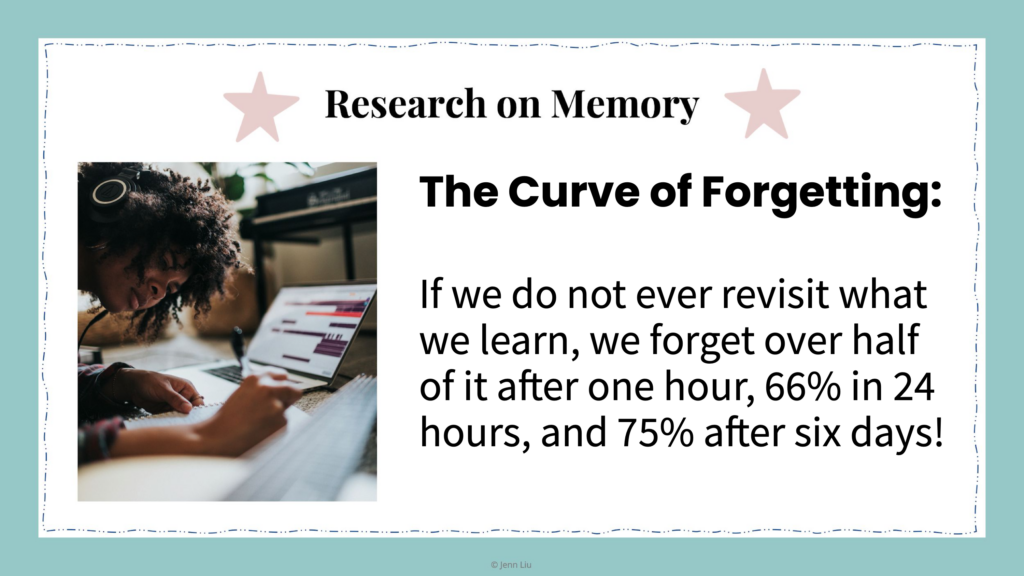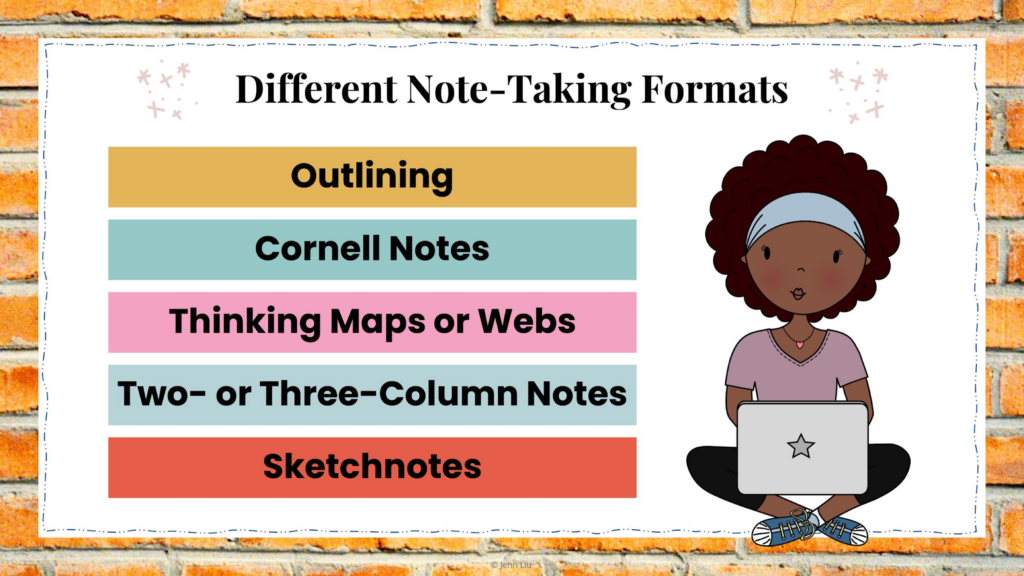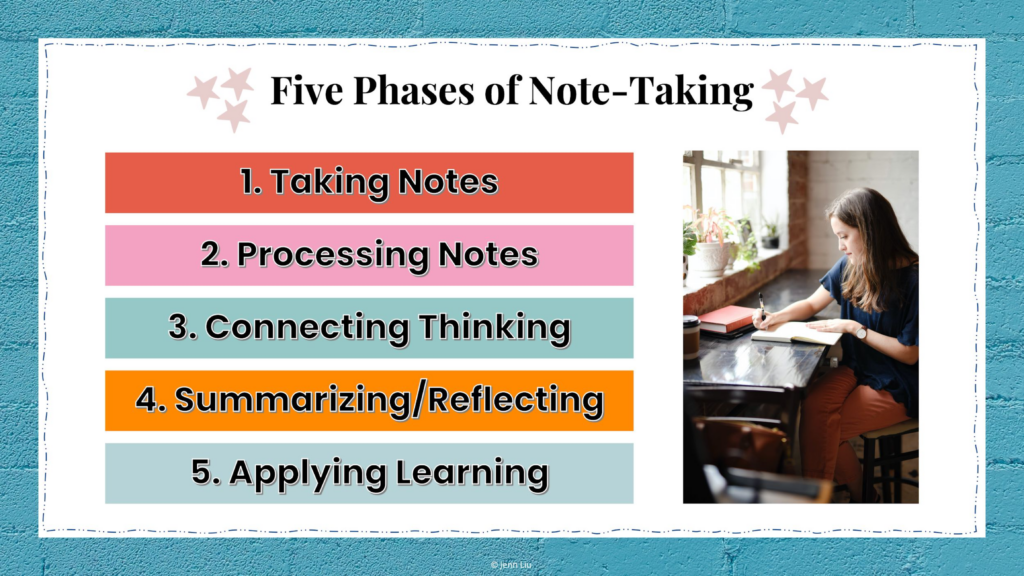If you’re a high school teacher, you know most students won’t take notes if not reminded, told they’re having an open-notes test, or bribed with candy. And if they do attempt some note-taking without having been taught how, the following often happens:
A few will just copy word-for-word from the text. Others will write the bare minimum, then lean back in their chair to sneak on TikTok. And one might even rebel and spend his forced note-taking time drawing a caricature of you.
What if I told you it’s entirely possible to get all your students to take amazing notes and actually make good use of them?
You know, notes with an essential question at the top, main ideas listed on the left side of the paper and related details on the right side with keywords circled, important ideas underlined, arrows linking related ideas, and symbols indicating “I agree” or “I don’t get this.” And OMG even a summary at the bottom!
Or how about notes organized in a way that match the text structure, such as notes about a compare/contrast article taken in the format of a Venn diagram, T-chart, or double-bubble map? (aka “focused notes”)
I think we both know the answer to the question above. (sign me up, right?)
So how do we get students to take good focused notes?
This can be hard if we’ve never taught focused note-taking before. Here are some suggestions:
- Review the Research on Memory and the Benefits of Taking Notes
- Share Different Note-Taking Formats
- Explain How to Take Notes
- Give Students Practice Taking Notes
- Provide Students with Note-Taking Support
I will explain each of these tips a little more, but if you’d like a very comprehensive and visually appealing interactive slides presentation to teach students about focused note-taking, click HERE!
1. Review the Research on Memory and the Benefits of Focused Note-Taking:
The curve of forgetting shows that within an hour of learning new information, we forget 50% of it, and after six days, this can increase to 75%!
Fortunately, there are strategies to increase retention! Research shows that we learn and retain more both from the process of taking notes and using our notes.
You could share this research with students by having them read studies about the benefits of note-taking (there are several), but this kind of academic reading might be a bit dull for them to get through with your limited time.
Instead, I suggest just sharing the forgetting curve theory along with how famous people such as free solo climber Alex Honnold, tennis star Serena Williams, and Seattle Seahawks Super Bowl champion quarterback Russell Wilson are known for keeping notes to help them be better at their sports. With a quick Google search, you could even find articles about how these athletes have used note-taking to help them, such as this one about Alex Honnold. You could also have students talk about their experiences with note-taking or ask your former students to give you personal testimony about how note-taking has helped them, and then share this with your students.
When you ask your current students to share about their experiences taking notes, you’re likely to have some students say they don’t think note-taking has helped them. This is when you can say that this is because research shows note-taking is more effective if it includes the following:
- Adding drawings to notes to represent concepts, terms, and relationships.
- Taking notes by hand (research finds students usually take more notes on a laptop but learn more using hand-written notes, most likely because they can’t write as fast as they type and must be more selective about what they write down in their notes; research also finds students are less distracted when they don’t have an electronic device out).
- Going back and reviewing and asking questions about what they take notes on.
By all means, feel free to use student-centered and inquiry-based approaches. In other words, ask students what they think would be effective note-taking strategies before you share the above findings with them!

2. Share Different Focused Note-Taking Formats:
To increase both the likelihood and effectiveness of students taking notes, it helps to not only stress the benefits of note-taking, but also explicitly teach the focused note-taking process.
Start by making sure your students understand what “focused note-taking” means!
Focused note-taking is the process of taking notes using a coherent format. It involves choosing a note-taking format, selecting important ideas, and reviewing and revising notes to improve understanding, retention, and application.
Emphasize that the format should match the content and purpose of the material and notes. Teach the following note-taking formats but allow students to experiment and choose a format that works best for them, thus increasing student motivation for taking notes.
- Outlining: This is the most traditional note-taking format and pretty straightforward. All students do is organize the information into headings, subheadings, and related details. They can use Roman numerals, bullet points, numbered lists, or arrows to indicate new ideas and indent to the right to show supporting subtopics and details.
- Cornell Notes: Cornell Notes usually have four sections: a small section at the top for the topic and an essential question, key ideas or questions in a column using one third of the paper on the left side, notes/details in the right column using the other two thirds of the paper, and a summary in the bottom portion. Cornell Notes are useful because they require reflection to write the summary and the paper can be folded back to study and just looking at the left side, and then checking the right side. Here is a video my students made to show how to take Cornell Notes.
- Thinking Maps or Webs: These are types of graphic organizers or visual patterns that spatially match the note-taking material or text structure, objective, and thought processes. For example, a Bubble Map could be used to take notes on a descriptive piece, a Tree Map could be used to show how a concept, topic, or thing is classified or has subcategories, and a Flow Map could be used to show the steps in a process or events in a story. Students who are more visual learners might prefer using Thinking Maps or other graphic organizers (e.g., Venn Diagrams) because this visual method of note-taking allows learners to show the importance and interrelationships between or among ideas. You can learn more about Thinking Maps here.
- Two- or Three-Column Notes: Students can also use different multi-column formats to take notes. What students put in their column will depend on what they are reading and their purpose. For example, if they are reading to gather ideas for discussion, they might use a “double-entry journal” in which they cite or paraphrase from the text in the right column and respond in the left column. You can choose other headings for the two columns to meet the needs of your lesson, such as pros/cons, facts/opinions, argument/evidence, or causes/effects. Or you could have students make three columns in a similar way to Cornell Notes with topics/key terms or questions in the left column, notes/details and examples in the middle column, and their responses (opinions, thoughts, observations, questions, etc.) in the right column.
- Sketchnotes: Any of the above note-taking formats can be combined with sketchnotes–using quick drawings alongside notes to help students better understand and remember what they are learning. The drawings will range from simple arrows, circles, boxes, and symbols that highlight, organize, and connect ideas to more elaborate doodles or pictures. One-pagers are one example of sketchnotes.
Note: Any of these formats can be incorporated into Interactive Notebooks with one side of the pages used for teacher input or further processing following pair sharing.

3. Explain How to Take Focused Notes:
As mentioned earlier, without training, students don’t usually instinctually take notes, so it’s helpful to discuss when they should. Other note-taking opportunities besides during lectures include: watching videos, reading textbook chapters, articles, or fiction, doing project research, or even going on field trips.
Note: While you might want to require students to take notes in these different situations, I prefer to not require notes but give students an assignment (e.g., a reading-based discussion or open-notes quiz) that makes taking notes seem like a very useful idea. However, when I first start teaching my students to take notes, I do make them a requirement and use a rubric for peer and self-checking, which I then use to give them feedback and points for having certain good note-taking features (e.g., essential question, organization, bullets or numbers, summary, markings/circling/underlining, etc.).
The AVID program recommends these five phases of focused note-taking:

PHASE 1: Taking Notes
Select a note-taking format, set up the note page, record the essential question, and take notes based on an information source (lecture, book, website, article, video, etc.), selecting, paraphrasing, and arranging information in a way that meets your note-taking objective.
PHASE 2: Processing Notes
Review and revise notes by underlining, highlighting, circling, chunking, questioning, adding, and deleting to identify, select, sort, organize, and classify main ideas and details. Evaluate the relative importance of information and ideas in the notes. (Students can work with partners to do this)
PHASE 3: Connecting Thinking
Analyze the notes using inquiry (e.g., Costa’s Levels of Thinking) to make connections and deepen content knowledge by asking questions and adding your own thinking to create greater understanding, identify gaps or points of confusion, and connect your new learning to what you already know.
PHASE 4: Summarizing/Reflecting
Pull together the most important aspects of your notes and your thinking about them to craft a summary that captures the meaning and importance of the content and reflects on how the learning helps you meet the note-taking objective.
PHASE 5: Applying Learning
Save and revisit your notes as a resource or learning tool to help you apply or demonstrate what you have learned. (i.e., do something with your notes)
Emphasize to students that 1) going through the phases of the focused note-taking process will help them to take good notes and apply their learning and 2) the note-taking process won’t be helpful and meaningful if their notes don’t have a purpose or application (e.g., to write a paper, prepare for a test, complete a project, participate in a Socratic Seminar, etc.).
4. Give Students Practice Taking Focused Notes:
For students to be good at note-taking, they need practice and ways to use the notes for active studying and test preparation. Here are some ideas:
- Model how you take notes using a document presenter, chart paper, white board, or note-taking app. (e.g., OneNote, Google Keep, Evernote).
- Have students make a poster or visual to compare the note-taking process to building something else (e.g., a house, ice cream cone, etc.) and ask them to identify all the steps in the process.
- Assign students to do a demonstration, video, slideshow, song/rap, or skit to explain the note-taking process.
- Play for students a good TED Talk or video in your content area to watch and take focused notes on.
- Give directions on how to do something, e.g., make a peanut butter and jelly sandwich or paper airplane or play a game (the more fun or silly, the better), and have students take focused notes as you or another person gives the instructions. Then see if you can all follow the notes!
- Assign students to research something they are interested in, take notes during their research, and then use their notes to share with the class what they learned.
5. Provide Students with Focused Note-Taking Support:
Here are several research-based techniques you can use to improve student note-taking:
- Provide partial/guided/skeletal notes.
- Provide note-taking cues (e.g., “This is important. Write this down”).
- Re-present the lesson (recording the lecture so students can re-watch it).
- Provide pauses and revision opportunities.
- Control laptop usage and “cyber slacking” or going on devices.
- Use presentation slides effectively (e.g., give students a copy of the slides with space for note-taking).
- Teach note-taking skills as explained above.
- Help students transform their notes (e.g., using AVID’s five phases of focused note-taking).
These are all helpful things teachers can do to help students take amazing notes (in their own words with markings that show understanding) and excel in school, but what you choose to do will depend on your students and your goals with them.
Click here for a FREE rubric you and your students can use to check their focused notes.
If you found this article helpful, share it with your teacher friends and colleagues!

Bold font